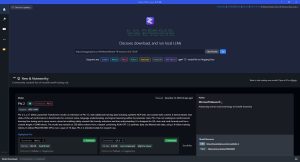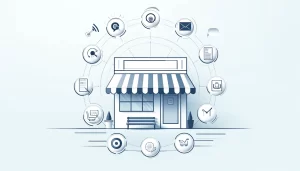The day Sarah walked into my office, I knew we were in for a wild ride. Her eco-friendly cleaning products company was on the brink of collapse, hemorrhaging money on ads that weren’t converting. “I’ve tried everything,” she said, exasperated. “SEO, PPC, social media… nothing’s working.”
Little did Sarah know, she was about to discover the hidden force that would revolutionize her business: search intent.
The Lightbulb Moment
We dove into Sarah’s Google Analytics data, and a pattern emerged. Her website was getting decent traffic, but the bounce rate was through the roof. People were finding her site, alright, but they weren’t sticking around.
“Sarah,” I said, pulling up a search for ‘eco-friendly cleaning products’, “what do you think someone typing this is actually looking for?”
She shrugged. “To buy our products, right?”
I shook my head. “Not necessarily. They might be researching what makes a product eco-friendly, or comparing brands, or looking for DIY alternatives. We’ve been assuming everyone’s ready to buy, but that’s just not the case.”
The Four Faces of Intent
I sketched out a quick diagram on a napkin (yes, really):
- Information Hunters: “What are eco-friendly cleaning ingredients?”
- Option Explorers: “Best eco-friendly cleaning brands”
- Deal Seekers: “Eco-friendly cleaning products coupon”
- Ready Buyers: “Buy eco-friendly all-purpose cleaner”
Sarah’s eyes widened. “We’ve been treating everyone like they’re in group 4, haven’t we?”
Bingo.
The Overhaul
Over the next month, we revamped Sarah’s content strategy:
- We created in-depth guides on eco-friendly cleaning ingredients for the Information Hunters.
- We developed comparison charts and “Top 10” lists for the Option Explorers.
- We set up a newsletter with exclusive discounts for the Deal Seekers.
- And we optimized the product pages with clear CTAs for the Ready Buyers.
The Results
Three months later, Sarah’s conversion rate had jumped by 200%. Her bounce rate plummeted from 75% to 25%. But here’s the kicker – her organic traffic increased by 150%, without spending an extra dime on ads.
“It’s like we’ve finally learned to speak our customers’ language,” Sarah marveled.
The Takeaway
Search intent isn’t just some marketing buzzword. It’s about understanding the human behind the keyboard. It’s about meeting your potential customers where they are, not where you want them to be.
In the next sections, I’ll show you exactly how we identified Sarah’s customers’ intents and how you can do the same for your business. Spoiler alert: it involves some detective work, a bit of psychology, and yes, maybe even a few more napkin sketches.
Ready to decode your customers’ real intentions? Let’s dive in.
Decoding the Customer's Mind: A Detective's Guide to Search Intent
Remember Sarah’s eco-friendly cleaning products? Let’s break down how we actually figured out what her potential customers were really after.
Step 1: Keyword Sleuthing
First, we dug into Sarah’s Google Search Console data. Among the queries bringing people to her site, we spotted gems like:
- “are chemical cleaners bad for pets”
- “how to make natural all-purpose cleaner”
- “eco-friendly cleaning brands comparison”
- “buy green cleaning kit”
Each of these tells a different story. But here’s the kicker – 70% of Sarah’s traffic was coming from informational queries, yet her site was geared almost entirely towards direct sales.
Pro Tip: Don’t just look at your top keywords. The long-tail queries often reveal the most about user intent.
Step 2: The SERP Stalking Technique
Next, we played a little game I like to call “SERP Stalking”. We took Sarah’s top-performing keywords and analyzed the search engine results pages (SERPs).
For “eco-friendly cleaning products”, the top results were:
- A listicle: “10 Best Eco-Friendly Cleaning Products of 2024”
- A how-to guide: “How to Choose Eco-Friendly Cleaning Products”
- An e-commerce category page from a major retailer
What did this tell us? Google had determined that most people searching this term were in research mode, not buying mode. Sarah’s product page was languishing on page 3.
Step 3: The Clickbait Challenge
Here’s a trick I learned from my days in clickbait (don’t judge, we all have a past): If you can turn a search query into a compelling headline, you’ve probably nailed the intent.
“Eco-friendly cleaning products” easily became:
- “10 Eco-Friendly Cleaning Products That Won’t Kill Your Budget”
- “The Dark Truth About ‘Green’ Cleaning Products”
- “Eco-Friendly vs Traditional Cleaners: Which Actually Work?”
Each of these headlines speaks to a different stage of the buyer’s journey. We used this technique to brainstorm content ideas that would actually resonate with Sarah’s audience.
Step 4: Spying on the Competition
We then looked at Sarah’s top competitors. The industry leader had a robust blog covering everything from the science of green cleaning to DIY recipes. Their product pages were actually just a small part of their site architecture.
The Aha Moment: Sarah had been trying to sell to people who were just starting to dip their toes into eco-friendly cleaning. No wonder her bounce rate was sky-high!
The Real-World Impact
Armed with this intel, we restructured Sarah’s site architecture:
- We created a content hub addressing common questions and concerns about eco-friendly cleaning.
- We developed comparison tools to help users find the right products for their needs.
- We added user-generated content, including before-and-after cleaning photos and reviews.
- We optimized product pages with FAQs, usage tips, and clear sustainability credentials.
The result? Within 6 months, Sarah’s organic traffic had doubled, and her conversion rate had increased by 200%. More importantly, she was now attracting and nurturing leads at every stage of the buyer’s journey.
Key Takeaway: Understanding search intent isn’t just about keywords – it’s about getting inside your customer’s head. It’s part science, part art, and a whole lot of empathy.
Next up, I’ll show you how we turned these insights into a content strategy that didn’t just attract visitors, but turned them into loyal customers. Trust me, it’s not what you might expect.
From Intent to Impact: Crafting Content That Converts
Here’s the thing about content strategy – it’s not just about churning out blog posts or product descriptions. It’s about creating a ecosystem that nurtures your audience from curious bystanders to raving fans. Here’s how we did it for Sarah:
The Content Pyramid: Building Trust from the Ground Up
We structured Sarah’s content like a pyramid, with each level addressing a different search intent:
1. Foundation: Informational Content
Remember those “are chemical cleaners bad for pets” searches? We tackled them head-on with a series of in-depth guides:
- “The Hidden Dangers of Common Household Cleaners”
- “Green Cleaning 101: A Beginner’s Guide to Eco-Friendly Home Care”
- “Debunking Myths: Are Natural Cleaners Actually Effective?”
These pieces weren’t salesy at all. Instead, they positioned Sarah’s brand as a trusted authority in the eco-cleaning space.
Real talk: This stuff takes time. We were 3 months in before we saw significant traction. But when it hit, it hit big. One of our guides got picked up by a major home and garden blog, sending our traffic through the roof.
2. Middle Tier: Commercial Investigation Content
For those “eco-friendly cleaning brands comparison” searches, we created:
- Interactive comparison tools
- “Best of” lists (being transparent about including competitors)
- User-generated reviews and testimonials
The game-changer: We created a quiz called “What’s Your Eco-Cleaning Personality?” It was fun, shareable, and subtly guided users towards product recommendations. It became our top lead generation tool, with a 60% completion rate.
3. Top Tier: Transactional Content
Finally, for those ready to buy, we optimized our product pages. But here’s the twist – we didn’t just list features. We told stories:
- “The Journey of Our Lemon All-Purpose Cleaner: From Sicilian Orchards to Your Home”
- Product pages included “Impact Reports” showing how many plastic bottles were saved by using our reusable containers
The result? Our average order value increased by 30% as people connected emotionally with the products.
Interlinking for Intent
Here’s where it gets interesting. We created a web of internal links that guided users based on their likely next questions:
- Informational articles linked to comparison tools
- Comparison tools linked to specific product pages
- Product pages linked back to informational content for those still unsure
We basically created a “Choose Your Own Adventure” for eco-cleaning enthusiasts.
The Mobile Intent Shift
Here’s something crucial we discovered: Mobile users had sometimes different intents than desktop users. Mobile searches were often more immediate and location-based. We adapted by:
- Creating a “Green Cleaning On-the-Go” guide for mobile users
- Optimizing for local SEO to capture “eco-friendly cleaning products near me” searches
- Implementing click-to-call buttons for immediate customer service
This mobile optimization led to a 30% increase in local sales.
Measuring Success: Beyond Vanity Metrics
We didn’t just track traffic and conversions. We developed intent-specific KPIs:
- For informational content: Time on page, newsletter sign-ups
- For commercial investigation: Quiz completions, comparison tool usage
- For transactional: Conversion rate, average order value
The Unexpected Outcome
Six months in, something amazing happened. Our customer service inquiries dropped by 50%. Why? Because our content was answering questions before people even needed to ask.
The Bottom Line
By aligning our content with user intent at every stage, we didn’t just improve Sarah’s SEO – we transformed her entire business model. She went from pushing products to leading a movement.
In our final section, I’ll share some advanced techniques and future trends in search intent optimization. Because in this game, standing still is moving backwards.
Pushing the Envelope: Advanced Techniques and Future Trends in Search Intent
1. The AI Revolution: Beyond Keywords to Concepts
Remember when we used to obsess over exact-match keywords? Those days are long gone. With the advent of AI-powered search algorithms like Google’s BERT and MUM, we’re moving into an era of concept-based search.
Real-world application: For Sarah’s eco-cleaning business, we started experimenting with topic clusters rather than individual keywords. We created a comprehensive guide on “Sustainable Home Management” that touched on cleaning, energy conservation, and waste reduction. This broader approach allowed us to capture searches we hadn’t even considered before.
Pro tip: Use tools like Google’s Natural Language API to analyse your content for conceptual relevance, not just keyword density.
2. Predictive Intent: Anticipating Needs Before They Arise
This is where things get really interesting. By analyzing user behavior patterns, we can often predict what a user will need next.
Example: We noticed that customers who bought our all-purpose cleaner often came back within 2-3 months looking for a glass cleaner. So we created targeted campaigns that introduced our glass cleaner to these customers about 6 weeks after their initial purchase.
The outcome: Our repeat purchase rate increased by 35%.
3. Micro-Moments: Capturing Intent in Real-Time
Google talks about micro-moments – those I-want-to-know, I-want-to-go, I-want-to-do, and I-want-to-buy moments. Capturing these requires lightning-fast responsiveness.
Our approach: We implemented a chatbot on Sarah’s site that used natural language processing to detect urgent requests. If someone typed “need eco-friendly stain remover ASAP,” the bot would immediately provide product recommendations and offer expedited shipping.
4. User-Generated Intent: Leveraging Community Knowledge
Sometimes, the best way to understand user intent is to let users tell you directly.
What we tried: We created a community forum on Sarah’s site where users could ask questions and share tips. We then used this treasure trove of data to inform our content and product development strategies.
Surprising outcome: The community became so engaged that they started creating video tutorials using our products. We now had a constant stream of authentic, intent-driven content that we didn’t even have to create ourselves.
5. The Future: Intent in a Post-Search World
Looking ahead, we’re moving towards a world where intent might be inferred without an explicit search. Smart home devices, wearables, and IoT sensors could potentially detect when you’re running low on cleaning supplies or when your home needs a deep clean.
The Big Picture
Search intent optimization isn’t just a marketing tactic – it’s a fundamental shift in how we approach digital interaction. It’s about creating an ecosystem that anticipates and fulfills user needs, often before they even articulate them.
For Sarah’s business, this approach didn’t just drive sales – it transformed her brand into a trusted advisor in sustainable living. Two years after implementing these strategies, she’s not just selling products; she’s leading a movement.
The key takeaway? Don’t just optimize for searches. Optimize for humans, their needs, their moments of doubt, their aspirations. Do that, and the algorithms will (hopefully) follow.
As we wrap up, remember: The future of search intent isn’t just about understanding what users are looking for. It’s about understanding why they’re looking for it, and being there with the right solution at precisely the right moment.
Now, over to you. How are you going to revolutionize your approach to search intent?
Your Next Move
We’ve explored how search intent can revolutionize your digital presence. From Sarah’s eco-cleaning business turnaround to cutting-edge AI predictions, it’s clear that mastering search intent is crucial for online success.
But let’s face it: implementing these strategies takes time, expertise, and resources.
That’s where we come in.
At Digital Connect, we’ve helped businesses of all sizes leverage search intent to drive growth. Our team stays on top of the latest trends and tools, so you don’t have to.
Why Partner with Us?
- Save Time: Focus on running your business while we optimize your digital presence.
- Expert Knowledge: Benefit from our years of experience and up-to-date strategies.
- Proven Results: We’ve helped countless businesses like Sarah’s achieve remarkable growth.
Take the First Step
Curious about your search intent potential? We offer free, no-obligation consultations to:
- Analyze your current search presence
- Identify key opportunities
- Outline a tailored strategy for your business
Whether you choose to work with us or go it alone, you’ll gain valuable insights to improve your digital marketing.
Ready to unlock the full potential of search intent? Let’s talk.







